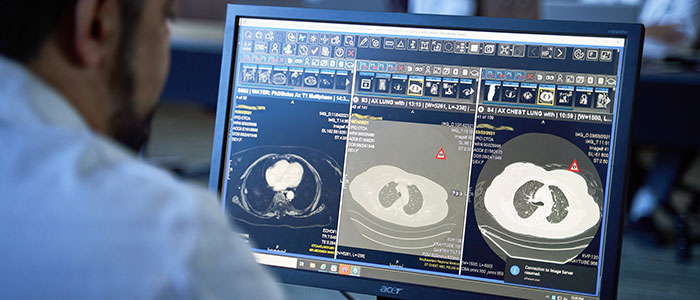
Cancer isn’t just one disease. It’s an umbrella term describing dozens of diseases that develop when cells in the body rapidly grow out of control. This unchecked growth happens when changes in genes cause cells to behave differently than normal.
And because every cancer is different, there’s no universal rate at which all cancers grow. Some cancers tend to remain in place and not grow much at all. Others grow slowly—so slowly that they may never require treatment. Aggressive cancers may grow and spread so quickly that they metastasize before the cancer has been diagnosed.
Various factors, including the cancer’s stage and grade (how abnormal the cancer cells look under a microscope), may affect whether and how each cancer grows and spreads. Doctors consider these factors when trying to predict cancer progression.
In this article, we’ll explain which cancers spread quickly and what impacts the speed of cancer development.
We’ll explore:
If you’ve been diagnosed with cancer and would like to learn more about our treatment options, or if you’re interested in a second opinion about your cancer diagnosis and treatment plan, call us or chat online with a member of our team.

How cancer spreads
There are two main types of cancer:
- Blood or liquid cancers, such as leukemia, lymphoma and multiple myeloma, develop in blood cells.
- Solid tumor cancers, like breast cancer and prostate cancer, begin in organs and tissues.
Cancer cells spread by traveling through the bloodstream or lymph system to other parts of the body. Most cells either die or are killed off before they start growing somewhere else. But a few may take root and grow in a new part of the body—a process called metastasis. No matter where cancer cells spread, the name of the cancer doesn’t change from the location the disease originated. For example, breast cancer that spreads to the lungs is called metastatic breast cancer, not lung cancer.
The few cells that do metastasize have to pass a series of steps, including:
- Growing into or invading normal tissue
- Evading the body’s immune system surveillance
- Moving through the walls of blood vessels or lymph nodes to travel to distant parts of the body
- Taking root in new tissue
- Developing an independent blood supply to grow and support a new tumor
Failure to complete any one step may terminate the process of metastasis. But when cancer cells spread, the effects may be devastating. Cancer that spreads and resists treatment is, in fact, the most common cause of death from the disease.
Stress and cancer metastasis
Certain environmental factors may promote or impede cancer growth and metastasis. One of these factors is stress. Over the past few decades, epidemiological and clinical studies have found strong evidence linking chronic stress—along with depression and social isolation—to cancer progression. In fact, research shows that the body’s stress response may trigger signaling pathways in cancer cells that may promote tumor growth and metastasis.
For example, when it’s under chronic stress (lasting a long period of time or frequently recurring), the body remains in a constant state of overdrive and immune function is suppressed. This may allow cancer cells to escape detection.
In fact, research has found that:
Cortisol, the body’s main stress hormone stimulates the growth of prostate cancer cells.
The levels of norepinephrine and epinephrine, the hormones feeding the body’s “fight or flight” response, are elevated in people with chronic stress and promote cancer development.
Stress may help facilitate cancer recurrence. A 2021 study found that stress hormones can wake up dormant cancer cells that have been pushed into hibernation during treatment. The study found that these hormones trigger a chain reaction in immune cells, awakening cancer cells that otherwise wouldn’t cause issues and prompting them to begin growing again and form new tumors. That study came after 2019 research that found that stress hormones may create the right environment for cancer cells to grow.
It may seem like an avalanche of bad news when it comes to stress (and especially chronic stress), but the ability to pinpoint specific signaling pathways to interrupt these links may present, in many ways, an opportunity to target those pathways with new treatments.
For example, studies have found that stress may disrupt neuroendocrine circadian rhythms and promote tumor growth and metastasis. But high doses of glucocorticoids (a class of steroid hormones that bind to the glucocorticoid receptor, a popular anti-inflammatory drug target) have been useful in restricting tumor growth.
How doctors project cancer progression
Doctors consider certain factors to predict cancer progression, including:
- The type and location of the cancer
- The cancer’s stage
- The cancer’s grade (how abnormal cancer cells look under a microscope)
- Certain other characteristics of the cancer, such as gene mutations and hormonal status
Stage and cancer development
Cancers are staged depending on the size of the tumor and whether it’s spread. Staging cancer helps doctors determine which treatments are more likely to work. In general, it’s easier to treat cancer before it’s spread.
Most cancers are assigned one of four stages, with the lowest stage describing early and small tumors and the highest stage referring to cancers that have progressed and spread.
Stage 1 or localized cancer: In this stage, the cancer hasn’t invaded deeply into nearby tissue, nor has it spread to the lymph nodes or locations away from the primary tumor.
Stage 2: Cancer cells have spread more deeply into neighboring tissue, but not yet to distant parts of the body.
Stage 3: Cancer cells have grown more deeply into neighboring tissue and spread to lymph nodes but haven’t yet spread to distant parts of the body.
Stage 4 (metastatic or advanced cancer): Cancer cells have spread beyond nearby tissue and into lymph nodes and distant parts of the body, including organs.
Some cancers, such as breast cancer, include a stage 0 or carcinoma in situ. This pre-cancerous stage describes a clump of abnormal cells that haven’t spread into neighboring tissue or elsewhere. Surgery may be recommended to remove stage 0 cancers.
Other cancers, such as Wilms tumor, or nephroblastoma—a childhood cancer that begins in the kidneys—include a fifth stage. Stage 5 Wilms tumors affect both kidneys.
Most adult cancers are staged using the TNM (tumor, node and metastasis) system, which assigns numbers and letters to describe each of the three aspects of a cancer listed below.
T: Size of primary tumor
- TX: Primary tumor can’t be measured.
- T0: Primary tumor can’t be located.
- T1, T2, T3, T4: These describe the size of the primary tumor and how far it’s grown into surrounding tissue.
N: Number of regional lymph nodes affected
- NX: Cancer in nearby lymph nodes can’t be measured.
- N0: No cancer is found in nearby lymph nodes.
- N1, N2, N3: These describe the number and location of affected lymph nodes.
M: Whether cancer has metastasized
- MX: Metastasis can’t be measured.
- M0: Cancer hasn’t spread to other parts of the body.
- M1: Cancer has spread.
Grade and cancer development
A tumor’s grade refers to how abnormal cancer cells look under a microscope, using the numbers below.
- GX: Undetermined
- G1: Well-differentiated
- G2: Moderately differentiated or intermediate grade
- G3: Poorly differentiated or high grade
- G4: Undifferentiated or high grade
Cancer cells graded as poorly differentiated or undifferentiated (meaning they have more genetic damage) tend to grow more quickly than those graded as undetermined or well-differentiated (meaning they have less genetic damage).
The most aggressive cancer types
Some of the most aggressive cancer types include:
- Acute myeloid leukemia (AML) and acute lymphoblastic leukemia (ALL)
- Glioblastomas, an aggressive form of brain cancer
- Certain breast cancers, such as inflammatory breast cancer and triple-negative breast cancer
- High-grade neuroendocrine carcinomas (including small cell lung carcinoma)
- Lung cancer
- Pancreatic adenocarcinomas
- Sarcomas
Having a fast-growing cancer doesn’t necessarily mean a poor prognosis. Similarly, other cancers, like cervical cancer and kidney cancer, don’t necessarily grow more quickly, but they’re less likely to cause symptoms until they’ve spread. For this reason, they often aren’t diagnosed until they’ve metastasized.
Some slow-growing cancer types include:
- Colorectal cancers
- Low-grade breast cancers, such as estrogen receptor-positive breast cancer (ER+) and human epidermal growth factor receptor 2-negative breast cancer (HER2-)
- Most types of prostate cancer
Certain cancers, like prostate cancer, may grow so slowly that your doctor may recommend a wait-and-see approach called “active surveillance” or “watchful waiting” rather than immediate treatment.
If you’ve been diagnosed with cancer and would like to learn more about our treatment options, or if you’re interested in a second opinion about your cancer diagnosis and treatment plan, call us or chat online with a member of our team.



